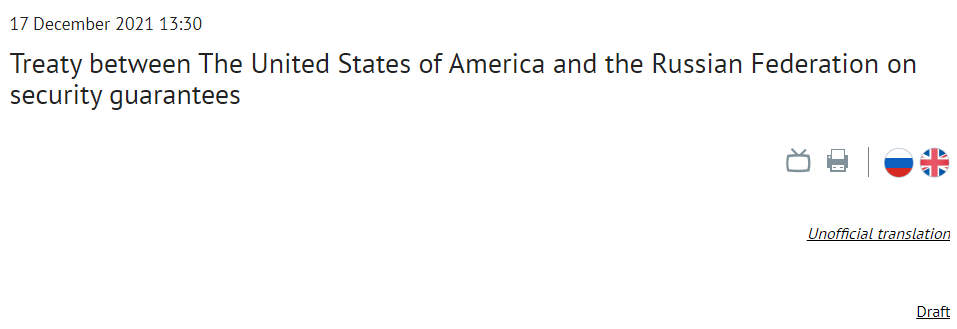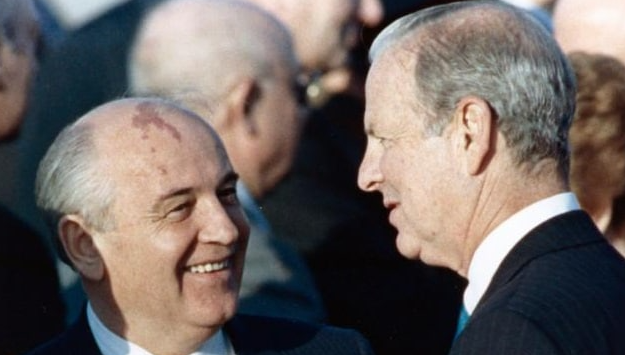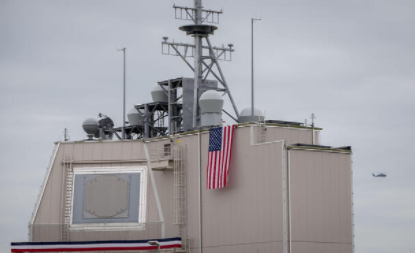[ad_1]
Yves here. It’s painful to keep on top of the unserious-by-design US effort to negotiate with Russia over Ukraine and the general issue of the US continuing to use NATO and NATO-lite arrangements to move men and materiel closer to Russia’s border. So Helmer deserves credit for scrutinizing another manifestation of America’s “not agreement capable” conduct, this in the form of a wildly misrepresented document that the US released in Madrid.
However, we have some unexpected good news. America’s performance is so shambolic that of all people, Emanuel Macron is successfully playing statesman by throwing spanners into our “escalate the hostilities” plan.
Above the fold at the BBC’s site: Deal to avoid war in Ukraine within reach – Macron.Suhbead:
France’s leader calls for a “new balance” to protect European states while affording Russia respect.
Key bits from the story:
French President Emmanuel Macron has said he thinks a deal to avoid full scale war in Ukraine is possible and that it is legitimate for Russia to raise its own security concerns.
Before talks in Moscow with Russian President Vladimir Putin on Monday, he called for a “new balance” to protect European states and appease Russia.
He restated that the sovereignty of Ukraine was not up for discussion….
Moscow has made a string of demands, including that the Nato defence alliance rule out Ukraine becoming a member, and that it reduces its military presence in eastern Europe.
Western countries have rejected this, instead suggesting other areas of negotiation, for example talks on cutting back nuclear weaponry.
Mr Macron told the Journal du Dimanche newspaper that Russia’s objective was “not Ukraine, but a clarification of the rules… with Nato and the EU”….
Mr Macron, who also spoke with US President Joe Biden on Sunday, cautioned against expecting Moscow to take unilateral measures to de-escalate the situation and said Russia had the right to raise its own concerns.
I imagine some head in State are exploding. Good.
By John Helmerthe longest continuously serving foreign correspondent in Russia, and the only western journalist to direct his own bureau independent of single national or commercial ties. Helmer has also been a professor of political science, and an advisor to government heads in Greece, the United States , and Asia. He is the first and only member of a US presidential administration (Jimmy Carter) to establish himself in Russia. Originally published at Dances with Bears
A soldier who lays a booby trap for his adversary thinks him fool enough to be tricked or lured to his own death. He thinks his enemy is inferior and deserves death. He hates him.
The German expression for war planned and executed like this is rassenkampf, race war. The German generals who planned and executed the 1941 invasion of Russia, Operation BARBAROSSA, claimed they didn’t hate the Russians. Their war was krieg ohne hasswar without hate. They said that after their surrender or capture, when they were facing war crimes trials.
US Secretary of State Antony Blinken (lead image, centre) hates Russians; thinks them inferior to Americans; fools compared to himself; deserving of the fate Blinken intends for them. The evidence is in the booby traps Blinken set in the document the State Department arranged to leak in a Spanish newspaper last week. It is called “NON-PAPER CONFIDENTIAL/REL RUSSIA Areas of Engagement to Improve Security”.
The State Department has announced in a double negative that it has “seen nothing to suggest these documents are not authentic.”
The paper claims to be a “response to Russia’s request that the United States provide a direct written response to Russia’s draft treaty proposal”. What follows is not a direct response to the seven substantive Russian treaty articles. Instead, it lays a booby trap for each of the seven Russian proposals with a reaffirmation of the US intention to continue with its plans to attack Russia from the territories of other states, from international waters and the airspace bordering on Russia – and much more.
To camouflage these booby traps, the Blinken paper lists these intentions as “Concerns”. The Blinken paper has issued 55 lines of “Concerns” one for each of the 55 lines of “US Position”.
Only three of the Russian treaty articles are identified in the Blinken paper – Articles 5, 6, and 7. By ignoring the first four articles of the Russian treaty the Blinken paper has declared its refusal “not to undertake actions nor participate in or support activities that affect the security of the other Party” (Article 1); its dismissal of the “core security interests of the other Party”; and its rejection of “the principles contained in the Charter of the United Nations (Article 2).”
The Blinken paper also declares the US intention to continue to “use the territories of other States with a view to preparing or carrying out an armed attack against the other Party or other actions affecting core security interests of the other Party” (Article 3); to encourage “further eastward expansion of the North Atlantic Treaty Organization” (Article 4); and to plan to “establish military bases in the territory of the States of the former Union of Soviet Socialist Republics that are not members of the North Atlantic Treaty Organization” , use their infrastructure for any military activities or develop bilateral military cooperation with them” (Article 4).
In the Blinken paper, that last point means it no longer matters to the US whether Ukraine joins NATO or not. The US intends to make war on Russia from the territory of the Ukraine across the Red Line.
Writers in the alternative media have made much of the failure of the State Department spokesman last week to provide any evidence for his allegation, widely printed in the mainstream media, that Russia has prepared a plan of fabricated attacks to justify an invasion of Ukraine. The media have all missed the bigger and more obvious fabrication – this is the text of the documents leaked in Spain last week.
Source: www.state.gov
To understand this fabrication and the war plan it conceals, it needs to be read beside the Russian treaty proposals of December 17 and compared, line for line, article by article.
Start here.
Source: https://mid.ru/
And then here.
Source: https://elpais.com/
Blinken Booby Trap 1. The reason Russian Foreign Minister Sergei Lavrov (lead image, left) has insisted publicly on a written US response to the Russian draft treaty is that he has repeatedly said, as has President Vladimir Putin, that the US makes promises it violates, including the verbal promises of February 1990 not to expand the NATO alliance eastwards (“not one inch”) to the Russian border. Lavrov and Putin have also said many times that the US violates its own signed treaty agreements. In responding with the leak in Madrid, the US is issuing an official paper it can deny to be official later on. The classification tag at the top confirms this intention. With CONFIDENTIALthe lowest possible classification to hold the leaker harmless, the State Department declares its position paper to be a “NON-PAPER”.
Record of the February 1-9, 1990, promises, including those of then-secretary of State James Baker to Soviet President Mikhail Gorbachev.
Transcript of the Baker-Gorbachev conversation, February 9, 1990.
Blinken Booby Trap 2. The paper claims that Ukrainian membership of NATO cannot and will not be negotiated between the US and Russia, according to Russia’s proposed Article 4. The US paper sets two preconditions for this non-negotiability: the first is that “issues related to NATO… will be addressed separately by the Alliance [and] with our Allies and partners”. The Ukraine is, in Blinken’s recent public formulations, the partner which currently holds priority over the Allies. Blinken’s second precondition relegates Article 4 to the “NRC…the appropriate forum for discussions of that issue (Russia’s proposed treaty Article 4)”. NRC stands for NATO-Russia Council. In practical effect, according to NATO’s one-member veto rulethe US allows itself to be blocked from negotiating with Russia on Article 4 – by Lithuania (or by Albania, Canada, Estonia, Iceland, Luxembourg, Poland, or Romania).
Blinken Booby Trap 3. Article 1 of the Russian treaty proposed that one state, like the Ukraine, cannot be armed, financed, and supported by the US or NATO to threaten the security of Russia, according to the “principles of indivisible, equal and undiminished security”. US agreement to the principle of “indivisible security” was signed twice – in Istanbul in 1999 and again in Astana in 2010. In the Blinken paper this is admitted. He then adds two qualifiers – “our respective interpretations of that concept” and “[it] cannot be viewed in isolation”. This means that Blinken interprets the indivisibility of security in Europe by dividing it into the NATO-Ukrainian version, and the Russian version.
Blinken Booby Trap 4. Russia has proposed to revive the intermediate-range nuclear forces treaty (INF). It has added in Article 4 that the US and Russia should also agree “not to deploy ground-launched intermediate-range and shorter-range missiles outside their national territories”. This wording applies to the US Navy’s Aegis offshore missile bases in Romania and Poland. Blinken’s reply ignores Article 4 entirely. Instead, it says it is willing to discuss “transparency measures and reciprocal commitments” covering “offensive ground-launched missile systems and permanent forces with a combat mission in the territory of Ukraine.” This implies that the US reserves the right to move nuclear weapons into Ukraine on a “temporary” basis, and that its decision to do this will be based on “consult[ation] with Ukraine”. This amounts to a provocative, and hitherto unpublished escalation of US arms in the Ukraine. In the “Concerns” section Blinken has attached a US offer to negotiate not to do this on condition that Russia withdraw from its “build-up of military forces in Crimea and on Ukraine’s borders”. This means that Washington is offering to trade the withdrawal of US nuclear weapons in Ukraine for Russian withdrawal of Russian nuclear weapons from Crimea and the Black Sea Fleet.
Blinken Booby Trap 5. Addressing the Romanian and Polish missile sites run by the US Navy – the Aegis Ashore Tomahawk bases – Blinken offers “a transparency mechanism to confirm the absence of Tomahawk [nuclear] cruise missiles at Aegis Ashore sites in Romania and Poland provided Russia offers reciprocal transparency measures on two ground-launched missile bases of our choosing in Russia.” One of the Russian targets identified in the paper is “modern dual-capable missiles in Kaliningrad”. Blinken also adds the NATO veto qualifier – “consult[ation] with Romania and Poland on this issue” plus “additional consultation in NRC”.
The US Navy’s nuclear missile base at Deveselu, Romania, under US Sixth Fleet command. For more detail, read. For the Russian Red Line warning of 2016.
Blinken Booby Trap 5. Russia has proposed Article 6 to withdraw the US Navy’s Aegis nuclear missiles from the surface fleets operating in the Black and Baltic Seas, and from their warhead transfer bases at Souda Bay (Crete, Greece), and Rota (Spain). The Blinken paper ignores this entirely, but demands negotiations on Russian nuclear or dual capable weapons deployed or stocked on Russian territory “near NATO Allies’ borders”. Blinken is also requiring that Russia agree to curb those of its weapons for which the US has no match – “novel intercontinental-range nuclear weapons delivery systems”.
Blinken Booby Trap 6. Until now, the paper declares“US and NATO current force posture is limited, proportionate, and in full compliance with commitments under the Russia-NATO Founding Act.” But this “proportionate compliance” is about to change. “Further Russian increases to force posture or further aggression against Ukraine will force the United States and our Allies to strengthen our defensive posture”. Blinken’s formulation implies that unless Russia withdraws from its own borders, including Crimea, the US proposes to respond with its own “proportionate” “multi-domain military buildup, more assertive posture, novel military capabilities, and provocative activities.” This is camouflage for US and Canadian trainers, mercenaries and special forces at the Donbass Contact Line; Turkish and Israeli drones and new NATO ordnance in the Ukrainian line of attack; US tripwire deployments to Germany, Poland, and Romania; and Anglo-American cyber and information warfare.
Attached to this booby trap is this proviso in the NATO document released in Madrid last week. Lacking a title, this public release is tagged “RESTRICTED” for which there is no US equivalent or restriction. In this document, the US and NATO now demand that Russia accepts Kiev’s rejection of the Minsk Agreements for military and political resolution of the Donbass conflict; as well as Georgian territorial claims on Abkhazia and Ossetia, and Moldova’s claims against Transnistria.

Source: https://elpais.com/
This is a selection of the Blinken booby traps. There are others if you read carefully. There is no prize for discovering them all. Not even a booby prize.
[ad_2]
Source link













